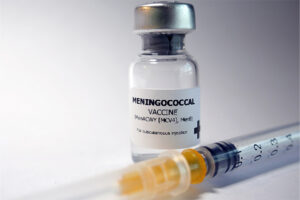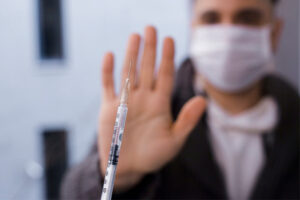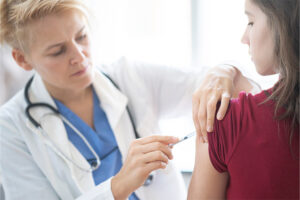Infectious Diseases
Adolescent Vaccinations
Adolescent Immunization: Implementing the Current Recommendations
Overview
Vaccines are intentionally recommended for specific age groups based on a number of different factors, such as waning immunity or a heightened risk of exposure to specific pathogens. Our featured experts offer insights into challenges and opportunities in adolescent immunization.
What are the recommendations for adolescent vaccination, and what tips can you offer to improve adherence to those recommendations?
Flor M. Muñoz, MD, MSc, FAAP
|
|
"One way to work within their peer environment would be for high schools and colleges to work with the schools' health clinics and/or with local health departments to make vaccines accessible and perhaps even to reward students by creating incentives to get vaccinated. It is important for individuals in this age group to have peer support so that they will complete their vaccinations and look after their own health.”
The Advisory Committee of the Centers for Disease Control and Prevention provides guidance for immunization in the adolescent population. Vaccines are recommended for adolescents for their protection against diseases they are susceptible to due to waning immunity of infant vaccines, such as tetanus, diphtheria, and pertussis (Tdap), and to optimize the protection they can receive against diseases that they could be exposed to in adolescence, such as human papillomavirus (HPV) and meningitis. So, at 11 to 12 years of age, we recommend a Tdap booster and starting the meningococcal and HPV vaccine series. In the case of HPV, when the series is started before age 15 years, only 2 doses of the vaccine are needed for most adolescents, with high efficacy in preventing HPV infection and its associated risk for malignancy in both female and male patients. Adolescents aged 16 years and older get a booster (second and final dose) for the meningococcal vaccine. The serogroup B meningococcal (MenB) vaccine is important for adolescents because of the increased risk of outbreaks on college campuses. However, this vaccine is recommended for all adolescents, with shared decision making between the patient, their parents, and their provider. We also have recommended annual influenza vaccination, and now there are recommendations for the updated 2023-2024 COVID-19 vaccines to be given to all adolescents aged 12 years and older.
The influences that impact vaccination decisions vary depending on the age of the adolescent. Younger children typically do not have as much decision-making power in their health care—it is the parent who makes most health care decisions. It becomes a different type of challenge to make sure that these vaccines are completed in the older age group, when adolescents are making their own choices and are experiencing big changes in their lives. They are busy finishing high school and transitioning out of the home. Encouraging vaccination according to the recommended schedule is a good way to improve vaccine coverage. One of the ways to improve vaccine coverage at that age is to make sure that parents have their adolescents complete routine pediatric visits every year during high school and before they go to college. Also, we have found that the use of text messages to remind teens and their parents of their upcoming vaccines can be effective. We also have used teens as champions encouraging other teens to be vaccinated.
The fact that colleges request information regarding vaccination status, especially for diseases such as meningococcal disease and, in some cases, influenza and COVID-19, is great because it means that these students will think about having updated vaccines when entering college. The risk of adolescents missing these vaccines is likely to be greater once they leave home. If the college has a good student health system and promotes vaccination, including through the engagement of vaccination champions among the student body and a culture of health and prevention, it is more likely that its students will complete the recommended vaccines and will seek annual influenza and updated COVID-19 vaccines.
There is an increased need to target the adolescent population. Life moves fast at this age, it is a busy and possibly vulnerable time, and adolescents are highly influenced by peers and social media. One way to work within their peer environment would be for high schools and colleges to work with the schools' health clinics and/or with local health departments to make vaccines accessible and perhaps even to reward students by creating incentives to get vaccinated. It is important for individuals in this age group to have peer support so that they will complete their vaccinations and look after their own health. We all need to help them understand that they do not want to miss out on being at their best when participating in all of the different activities that adolescents engage in at this age, such as classes, sports, music, art, college visits, and graduation!
Robert W. Frenck Jr., MD
|
|
“My contention is that if a patient is in the office to get the meningococcal or Tdap vaccine, they certainly can get the HPV vaccine at the same time. In fact, if you have them in the office, even if they are there for a broken leg, check their vaccine schedule and give them any recommended vaccines that they have not received. We should actively try to get every teenager vaccinated at every opportunity. . . ."
If you look at the vaccination rates for adolescents, approximately 90% of these individuals have received the Tdap vaccine and the first meningococcal conjugate (MenACWY) vaccine dose, but less than 60% have also received the MenACWY booster or are up to date on HPV vaccines. To improve adherence to the recommended vaccination schedules, it is important for providers to treat all vaccines the same in their discussions with patients and their parents. For example, we have found that many health care providers recommend the Tdap and the MenACWY vaccines for adolescents outright, but they recommend the HPV vaccine differently by saying, for example, “By the way, there's an HPV vaccine that you may also want to consider taking.” Such statements make a vaccine seem secondary, which decreases the likelihood that someone is going to get it.
My contention is that if a patient is in the office to get the meningococcal or Tdap vaccine, they certainly can get the HPV vaccine at the same time. In fact, if you have them in the office, even if they are there for a broken leg, check their vaccine schedule and give them any recommended vaccines that they have not received. We should actively try to get every teenager vaccinated at every opportunity by telling them something like, "There are 4 vaccines that you need today," (5 if there is a COVID-19 vaccine available too). No single vaccine is more important than the others. We have actually found that vaccination rates improve when patients have a strong provider recommendation.
People express concern that getting multiple vaccines at once will overload the immune system and deliver too many antigens at one time. However, if you look back to when we administered a whole-cell pertussis vaccine, the vaccine had thousands of antigens by itself. If people could tolerate thousands of antigens, it is difficult to make a rational argument that they cannot tolerate a few hundred antigens, which is what our whole vaccine panel (over all of childhood) delivers right now. So, giving all of the vaccines at once does not overload the immune system. Your arm may be a little bit sore, but the immune system can tolerate it.
Reducing the number of injections that are needed to complete a recommended vaccination series might also be helpful. In my experience, it has been helpful with the HPV vaccine that children and adolescents younger than 15 years of age can get a 2-dose instead of a 3-dose regimen. It would also be helpful if they could extend the data to teens who are older than 15 years of age. The fewer doses needed, the more likely it is that you are going to get a patient to complete the entire regimen.
Gary S. Marshall, MD
|
|
“If you look at the MenACWY vaccine, we have an 85% to 90% uptake for the initial vaccination, but only a 50% uptake for the booster. The issue is not one of suddenly becoming opposed to vaccination, but rather that adolescents begin to drop off the map of preventive health care once they become more independent.”
I totally agree with the concept of presenting a package deal for the meningococcal, Tdap, and HPV vaccines. With regard to the HPV vaccine, where we do not have as high of an uptake, one solution would be to give it at an earlier age. There is a lot of evidence that it is perfectly acceptable to initiate the HPV series at age 9 years. If you do that, the uptake is higher, the opposition is lower, and you can frame the vaccine as a cancer prevention vaccine without talking about sex.
If you look at the MenACWY vaccine, we have an 85% to 90% uptake for the initial vaccination, but only a 50% uptake for the booster. The issue is not one of suddenly becoming opposed to vaccination, but rather that adolescents begin to drop off the map of preventive health care once they become more independent.
How do we rectify that? One solution might be to engineer a fix into the health care system. For example, some immediate care and urgent care centers are offering sports physicals to get students approved quickly before they go back to school; they might be less likely to address vaccinations compared with the person’s medical home. It would be great if we could somehow link those sports physicals to the patients’ histories and insert “best practice advisories,” or hard stops, to encourage vaccination during those visits.
One other thing that I wanted to mention is the concept of vaccine mandates. If you go back to the late 1980s, when we had a resurgence of measles, we embraced mandating the second dose of the measles, mumps, and rubella (MMR) vaccine before a child could go to school. That mandate was instrumental in improving the rates of 2-dose MMR vaccine completion and squelching the resurgence of measles. The political times and the general population’s thinking about government mandates have changed. I am concerned that vaccination mandates will no longer be viewed as a viable option in today’s climate.
References
Boakye EA, McKinney SL, Whittington KD, et al. Association between sexual activity and human papillomavirus (HPV) vaccine initiation and completion among college students. Vaccines (Basel). 2022;10(12):2079. doi:10.3390/vaccines10122079
Centers for Disease Control and Prevention. Child and adolescent immunization schedule by age. CDC Website. Updated April 27, 2023. Accessed May 15, 2023. https://www.cdc.gov/vaccines/schedules/hcp/imz/child-adolescent.html
Masaquel C, Schley K, Wright K, et al. The impact of social determinants of health on meningococcal vaccination awareness, delivery, and coverage in adolescents and young adults in the United States: a systematic review. Vaccines (Basel). 2023;11(2):256. doi:10.3390/vaccines11020256
Pingali C, Yankey D, Elam-Evans LD, et al. National, regional, state, and selected local area vaccination coverage among adolescents aged 13-17 years – United States, 2020. MMWR Morb Mortal Wkly Rep. 2021;70(35):1183-1190. doi:10.15585/mmwr.mm7035a1
Roper L, Hall MAK, Cohn A. Overview of the United States' immunization program. J Infect Dis. 2021;224(12 suppl 2):S443-S451. doi:10.1093/infdis/jiab310
Talbird SE, Carrico J, La EM, et al. Impact of routine childhood immunization in reducing vaccine-preventable diseases in the United States. Pediatrics. 2022;150(3):e2021056013. doi:10.1542/peds.2021-056013













